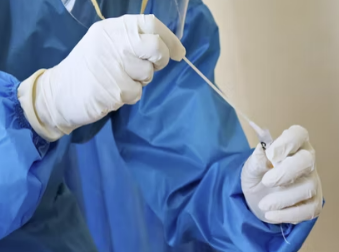RT-RPA nfo for Detection of SARS-CoV-2 in Covid-19 Specimens
BACKGROUND
COVID-19 has caused a global pandemic. As a result, several assays and detection processes have been developed. Covid diagnostics is a huge market estimated at over $84 bn in 2020 and is expected to expand at a compound annual growth rate (CAGR) of 3.1% from 2021 to 2027. Although there are 100s of Covid diagnostic tests being developed by companies around the world, there are very few that are RPA-based. As a result, OSU’s novel test can provide a differentiated value to COVID-19 testing laboratories and facilities, particularly those that cannot afford investing into RT-PCR. There are over 50 new diagnostic assays that have received Emergency Use Authorization from 2020 until today.

Although RT-PCR is highly sensitive and is routinely used for Covid 19 testing it suffers from the following limitations
- Complicated sample collection that increases overall diagnostic costs.
- False-negative results because of low viral titers following several times dilution of patient’s RNA into either Universal Transport Media (UTM) or Virus Transport Media (VTM).
- Added costs and logistics because of sample refrigeration requirement during transportation from a peripheral point of care to centralized laboratories.
- Substantial upfront cost from investing into RT-PCR infrastructure make this test hardly affordable to developing countries.
- Recombinase polymerase amplification (RPA) is a single tube, isothermal alternative to the polymerase chain reaction (PCR). By adding a three core enzymes, a recombinase, a single-stranded DNA-binding protein (SSB) and strand-displacing polymerase to an RPA reaction the test can detect both RNA and/or DNA targets without the need for a separate step to produce cDNA. Isothermal, RPA requires simpler and less costly equipment than PCR. In its simplest implementation, RPA reactions can be run quickly and simply by holding a tube at a temperature of 37–42 °C. This makes RPA an excellent candidate for developing low-cost, rapid, point-of-care molecular tests, especially in developing countries.
SUMMARY OF TECHNOLOGY
OSU investigators have invented a new RPA-based diagnostic technology for collection, sample handling and storage, and rapid diagnostic of the severe acute respiratory syndrome coronavirus 2 (SARS-CoV-2). Our novel diagnostic platform consists of A) A patented elution independent collection device (EICD) and method to improve virus yields at sampling, (U.S. Patent US 9,423398B2 owed by OSU), and B) novel sets of primers and corresponding specific probes for detection of RNA dependent genes of the SARS-CoV-2 (PCT application). By applying the isothermal RT-RPA to nucleic acid lateral flow immunoassays (NALFIA), commercially available as PCRD or alternative, our new approach proved to be sensitive to fewer than ten copies. We demonstrated that RPA reaction products can be detected in simple sandwich assay from EICD collected virus, for a thermocycler-free RNA testing system. Two new RPA assays, as briefly described below, have been developed and validated.
- An RPA nfo based, which RPA reaction function with two primers and one probe.
- An RPA basic, which RPA reaction function with two labeled primers and NO probe.
Advantageously, these RPA assays were developed as single step reactions coupled to NALFIA devices, and both assays provide a very low limit of detection. Yet, the second assay is more cost effective because it does not require a probe. The RPA assays were tested in vitro using validated artificial RNA positive controls and demonstrated capability to detect the SARS-CoV-2 variants Wuhan, Japan, USA (Texas) the two England variants, South Africa, and Delta. In summary, our experimental results prove feasibility for advance, portable and broad accessible test for developing countries and regions in the US that have more limited hospital infrastructure.
MAIN ADVANTAGES
- Rapid test that takes less than 1 hour to obtain results and that requires minimal training (just pipetting).
- The test’s sensibility and specificity are comparable to PCR-based amplification.
- Invented sets of primers and probes are compatible with two isothermal RT-RPA coupled to NALFIA (lateral flow device) for visualization of the test result, and the gold-standard RT-PCR assay.
- Low capital expenditures, and reduced costs of reagents because, in contrast to RT-PCR, the two developed isothermal RPA methods only requires an inexpensive dry-bath and pipettes.
- The new test is particularly well-suited for environments with limited hospital infrastructure and where low cost Covid diagnostic is desired (e.g., developing countries).
- FDA provides emergency use authorization (EUA) allowing accelerated FDA review and approval process of Covid-related technologies.
STAGE OF DEVELOPMENT
Patent Information:
| Title |
App Type |
Country |
Serial No. |
Patent No. |
File Date |
Issued Date |
Expire Date |
Patent Status |
|
|
|
Inventors:
Keywords:
|